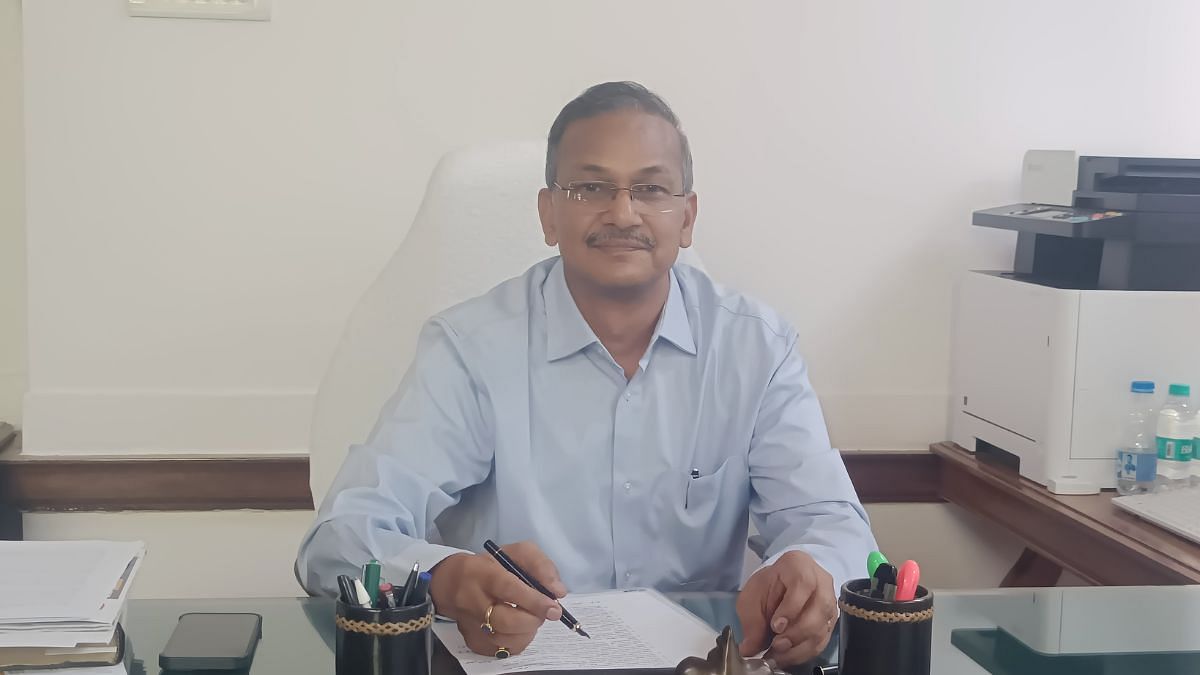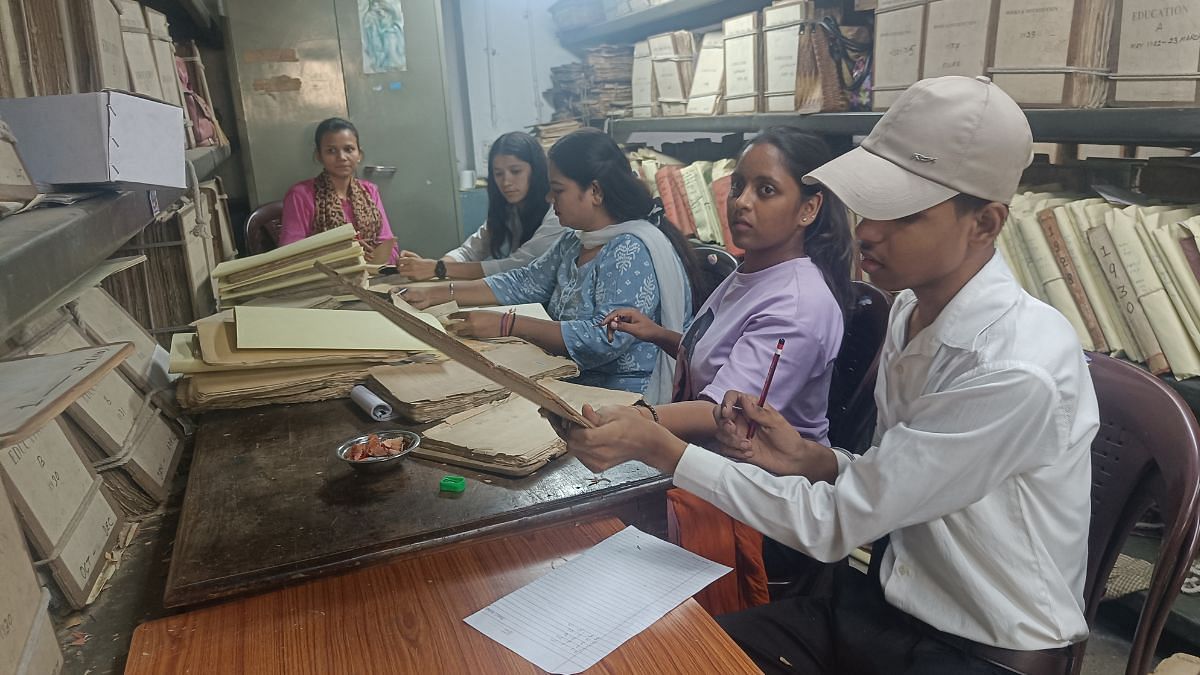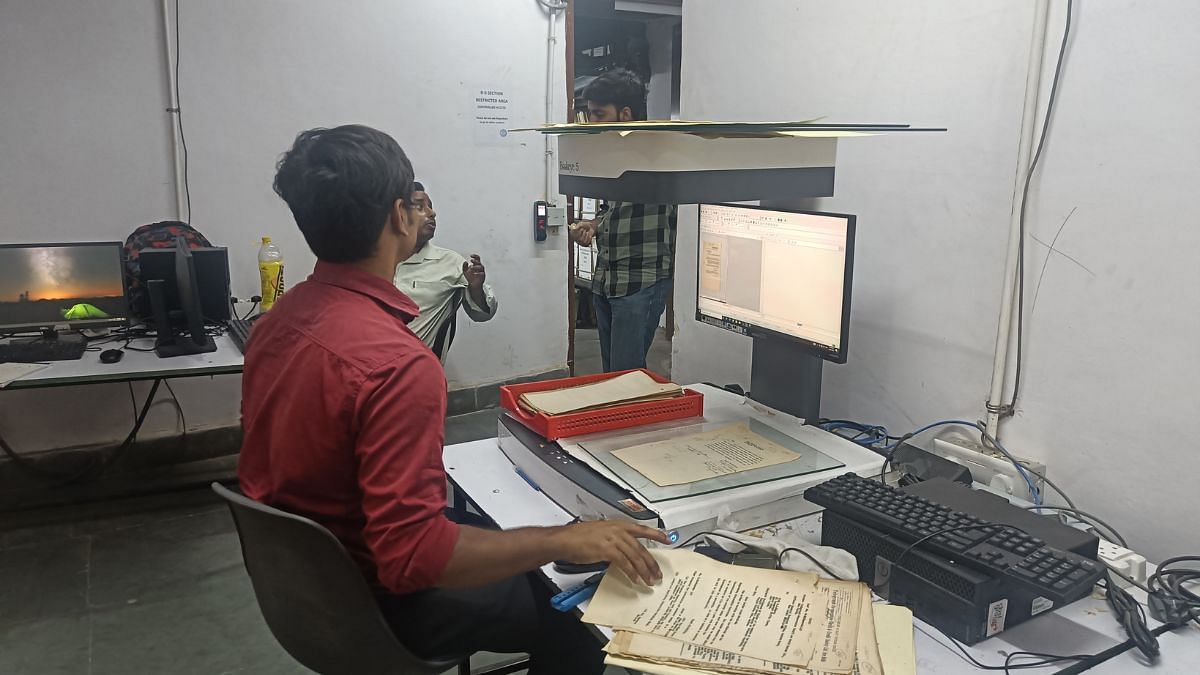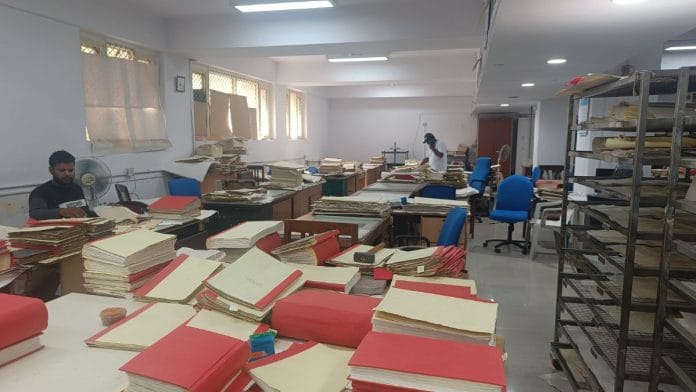New Delhi: It isn’t every day that you get your hands on the Mountbatten plan on Partition. But that is what a day in the massive National Archives digitisation project in Delhi looks like these days.
The document, dated 3 June 1947, was literally like holding history in his hands, said Abhishek Kumar. This is his first job. His jaw dropped at the discovery and he couldn’t stop talking with friends, family and colleagues about it for days. Twenty-six-year-old Kumar is part of a huge army of young people stationed at the archives round the clock, digitising archival records in what officials call is the largest project of its kind in the world.
As many as 34 crore pages—bundled for decades in red muslin cloth inside rows of open metal shelves—are being digitised on such a massive scale by over 400 young men and women across two office floors. The basement of the National Archives of India (NAI) annexe is also being cleared for scores of new work stations. Another 400 will join in September. The workers have a tight deadline of 2026 that adds to the frenzy. They are able to digitise four lakh pages per day currently and their goal is to take it up to six lakh daily.
Stacks of fraying, fragile papers lay on their tables in a largely silent floor, broken only by the whoosh of dozens of scanners.
“Those papers bring me back to history. I have read about the Mountbatten plan in my history books and seeing those documents is a rare experience for me,” said Kumar. He even clicked photographs of the documents as a souvenir. “I didn’t share it on social media though. It is a sensitive document.”
After scanning, the Partition document is now safely restored and is back to the original shelf from where it was taken. The shelf itself is over 60 kilometers long.
The state of India’s archives is woeful, mirroring the bureaucratic apathy and disregard for historical evidence. Many state-run archives are worse. Digitisation efforts are still largely patchy and underfunded. The NAI digitisation is already way behind.
The digitisation drive has deployed youth aged 20-30, trained for two weeks under the Skill India program, for the next two years.
Till now, 325 students, mostly from middle-class families, have been trained and in the next few months a strength of 1,000 people will get to work.
The data produced after digitisation is around 15 petabytes with the digitised paper being uploaded on Abhilekh Patal, a web portal to access the NAI’s reference media and its digitised collections. As of 20 June, around 2.93 crore pages have been uploaded.
“This Skill India course is very helpful for us. It provides the job I’ve been looking for many months,” said one of the employees on his way back home after completing the morning shift on Tuesday.
The Ministry of Culture said in Parliament this year that in the second phase, the NAI has initiated a project for digitising of all its records through an outsourcing agency.
“Our School of Archival Studies has limited capacity to provide training, so we tied up with the Skill Ministry. This way the ministry’s goal of providing skills was achieved and our work was also done. This is a win-win situation for both,” said Arun Singhal, Director General of NAI, sitting inside the heritage building.

“When old records come into our hands, it feels great. Because now we have the responsibility of handling them, it feels like a very big task as our process is very rare,” said Sashi Bhushan, who repairs 50-60 documents each day. It’s his first job.
The onus to do the mammoth work of digitisation is on the young people who have come from small towns and are being paid between 15-20k per month.
Preserving the heritage
The NAI is one of the five buildings designed by Lutyens in the 20th century and it’s also part of the Modi government’s Central Vista project.
In 2021, the government announced that the main building would remain intact, while the annexe would be replaced with a new structure as part of the Central Vista redevelopment project. But the move had raised concerns about the safety of the sensitive documents stored inside the building so the plan to demolish the annexe was dropped.
“We have very old rare records, it is India’s heritage which is kept with us. It is obvious that when there are so many interesting documents, people will want to see them. Our entire existence is to keep these records properly. So, the best way is to scan and digitise them,” said Singhal, a 1987 batch IAS officer.
Singhal said the archives contain farmans (decree) from the time of Nur Jahan, papers belonging to the Tughlaq dynasty period, letters of Queen of Jhansi, old manuscripts and even the original copy of the Constitution.
One of the papers is from 1947 when KM Munshi was appointed as the diplomatic envoy to the Princely State of Hyderabad. The heritage building of NAI also has documents from education, sanitary, and home departments of the early 20th century.
Also Read: Assam State Archives shows how it’s done—5 lakh documents, 6000 maps, digitisation drive
Digitisation Process and the fragility of manuscripts
Jaishankar Prasad, one of the prominent figures of modern Hindi literature, wrote Kamayani in 1936. It is one of his most famous writings. The original manuscripts of it are preserved at the NAI.
The heritage building also has private documents of personalities such as MK Gandhi, Chakravarti Rajagopalachari, and Rajendra Prasad.
Recently the NAI has acquired a private collection of former Union minister Rafi Ahmed Kidwai, which includes his correspondences with eminent leaders such as Jawaharlal Nehru, Sardar Patel and Shyama Prasad Mukherjee.
“I feel thrilled everytime I look at them. Even today if I see the original FIR, which was lodged after Mahatma Gandhi was assassinated, it gives me goosebumps,” said Singhal.

In the old colonial-era heritage building of NAI, many youngsters digitisers were busy paginating with pencils. Their tables are full of pencil shavings.
They first brush the papers, mostly in damaged condition, with Carboxymethyl cellulose (CMC) gel and then label it with a tissue paper before leaving it to air-dry. After that, the papers go to another person who stitches them together and sends them for digitisation.
According to Singhal, about 15 per cent (4.5 crore pages) of the archives are in fragile condition and have turned black due to moisture and fungus. “So, it is important to digitize them in time,” said Singhal.
The journey of a document from the shelf to conservation and then to digitisation takes place in many phases and in such a situation the files remain in one department for many days. To ensure that the documents remain safe, different people have been appointed who work on the distribution and collection of files, according to Dinesh Kumar, Director, Operations of Digitisation.
Documents are taken from the archive repository and bar codes are put on them. After pagination, scanning is done by Bookey 5 scanner, an overhead scanner that scans without making contact with the document, Kumar explained.

A total of 75 scanners are installed at various centres of the NAI such as in Bhopal, Jaipur, Bhubaneswar, and Puducherry.
One scanner can scan four to five thousand pages in an eight-hour shift.
Also Read: Do archives truly own the records they have? Guidebook for archivists can bridge laws, ethics
A bigger plan
Digitisation of archival records started in the 1990s but in the initial 30 years, only 20 lakh pages were digitised. In 2021, its pace was increased under the former Director General Chandan Sinha.
Between 2021-2024, which was the first phase, around 4.5 crores pages were digitised. The second phase started in April this year, which has the biggest target of digitising all the remaining 30 crore pages.
Apart from the digitisation programme, Singhal is on the mission to bridge the gap between all the state governments and private archives and bring them all on a single platform. Last year, he called a meeting of the National Committee of Archivists in Bikaner, Rajasthan. This body has largely been inactive through the last decade.
In the meeting, it became clear that everyone was facing similar issues. “There was a need for standardisation of all archives so that all archives could carry out digitisation work in the same manner. A standard operating procedure (SOP) should be made, which everyone could follow and there is a consensus on standardisation of metadata,” said Singhal.
India has more than 600 archives and the NAI is working on creating a common metadata repository. It’s also working to improve the search algorithm using AI. “So that when anyone will search for any subject, all the information from across the archives will reflect on the same page,” he said.
“We are working under Public Records Act and all the records are public so it’s important that it is available for all the citizens,” Singhal added.
Last month, a conservator working on the archives, Bhushan, gasped when he saw a yellowing 150-year-old sheet – it was MK Gandhi’s hand drawn horoscope. The writing was in Gujarati. It was a rare find and stunned him.
“We are handling thousands of sheets everyday and all are of national importance. But Mahatma Gandhi’s horoscope was very special to conserve,” he said.
Fascinated, he told his family about it and even got the horoscope translated from Gujarati to Hindi. Then he took it to a pandit (Hindu priest) and shared the information received from the reading with his colleagues.
“The pandit informed me that Gandhiji’s horoscope predicted he would die on 30 January 1948,” Bhushan said.
(Edited by Aamaan Alam Khan)






